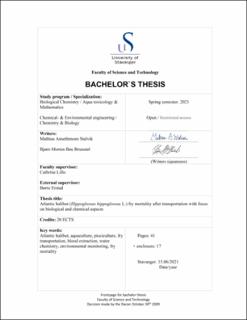| dc.contributor.advisor | Lillo, Cathrine | |
| dc.contributor.advisor | Erstad, Børre | |
| dc.contributor.author | Brunstøl, Bjørn Morten Bøe | |
| dc.contributor.author | Stalvik, Mathias Ansethmoen | |
| dc.date.accessioned | 2022-02-01T16:52:04Z | |
| dc.date.available | 2022-02-01T16:52:04Z | |
| dc.date.issued | 2021 | |
| dc.identifier | no.uis:inspera:72111992:36566605 | |
| dc.identifier.uri | https://hdl.handle.net/11250/2976391 | |
| dc.description.abstract | This thesis is a project finalizing Bachelor of Science degrees in the fields of biological
chemistry and chemical- & environmental engineering. As the literature database for Atlantic
halibut fish farming is scarce, the need for research is evident and potentially innovative. The
intention for this thesis was to show initiative contacting a company within the common field
of interest that is fish farming and establish a mutually positive project. As a response to
inquiry, Sterling White Halibut (SWH) presented a current problem that was very intriguing
and relevant in an educative regard. The thesis project was designed in collaboration with
SWH. The focus areas for monitoring were biological stress and water chemistry.
Hippoglossus hippoglossus fry (6.70 ± 2.35 g) was transported approximately one thousand
kilometers from Rørvik to Imsland. This thesis concerns one batch of 94 186 Atlantic halibut
fry, with arrival at Imsland in March 2021. Measurements were made upon arrival and for
one month after delivery. SWH reports that a late onset mortality occurs after transportation
of small fry sent from the hatchery to the rearing facilities. Some fry batches have endured
substantial mortality which is considered caused by the transportation and transfer of fry. The
complex phenomenon of late onset mortality after transportation required investigation.
Water sampling and chemical analysis were performed in two stages. First stage was at
arrival. Analysis of transportation water compared to receiving water presented a relatively
large difference in water quality. The second stage was comprised of daily analysis of the
water quality to monitor changes during the expected period of mortality. These differences
were relatively minor. Biological parameters were measured at arrival and monitored
afterwards on each of the three field excursions to complement the water quality data. These
datasets served as the basis for the graphical- and statistical analysis. Mortality was
considered the prime biological parameter of which the other data were evaluated against.
Correlation (r = -0.44) between pH and mortality was discovered and 19 % of the variation
observed is explained by the regression model of pH and mortality.
Abrupt environmental differences in transportation water compared to receiving water was
revealed, which contributes to additional stress after transportation. Stress levels were
indicated by elevated blood glucose concentration and increased red blood cell (RBC) count.
Late onset mortality is suggested as a consequence of stress during and after transportation,
including an unsuccessful adaptation to a new environment at the rearing facilities. | |
| dc.description.abstract | This thesis is a project finalizing Bachelor of Science degrees in the fields of biological
chemistry and chemical- & environmental engineering. As the literature database for Atlantic
halibut fish farming is scarce, the need for research is evident and potentially innovative. The
intention for this thesis was to show initiative contacting a company within the common field
of interest that is fish farming and establish a mutually positive project. As a response to
inquiry, Sterling White Halibut (SWH) presented a current problem that was very intriguing
and relevant in an educative regard. The thesis project was designed in collaboration with
SWH. The focus areas for monitoring were biological stress and water chemistry.
Hippoglossus hippoglossus fry (6.70 ± 2.35 g) was transported approximately one thousand
kilometers from Rørvik to Imsland. This thesis concerns one batch of 94 186 Atlantic halibut
fry, with arrival at Imsland in March 2021. Measurements were made upon arrival and for
one month after delivery. SWH reports that a late onset mortality occurs after transportation
of small fry sent from the hatchery to the rearing facilities. Some fry batches have endured
substantial mortality which is considered caused by the transportation and transfer of fry. The
complex phenomenon of late onset mortality after transportation required investigation.
Water sampling and chemical analysis were performed in two stages. First stage was at
arrival. Analysis of transportation water compared to receiving water presented a relatively
large difference in water quality. The second stage was comprised of daily analysis of the
water quality to monitor changes during the expected period of mortality. These differences
were relatively minor. Biological parameters were measured at arrival and monitored
afterwards on each of the three field excursions to complement the water quality data. These
datasets served as the basis for the graphical- and statistical analysis. Mortality was
considered the prime biological parameter of which the other data were evaluated against.
Correlation (r = -0.44) between pH and mortality was discovered and 19 % of the variation
observed is explained by the regression model of pH and mortality.
Abrupt environmental differences in transportation water compared to receiving water was
revealed, which contributes to additional stress after transportation. Stress levels were
indicated by elevated blood glucose concentration and increased red blood cell (RBC) count.
Late onset mortality is suggested as a consequence of stress during and after transportation,
including an unsuccessful adaptation to a new environment at the rearing facilities. | |
| dc.language | eng | |
| dc.publisher | uis | |
| dc.title | Atlantic halibut (Hippoglossus hippoglossus L.) fry mortality after transportation with focus
on biological and chemical aspects | |
| dc.type | Bachelor thesis | |
